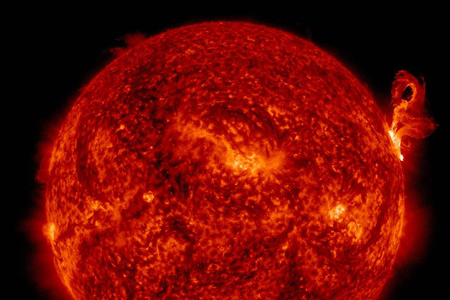In the United States, NASA maintains a constant watch on the sun. The monitoring work is performed at the space agency’s Goddard Space Weather Research Center, which issues warnings when especially powerful eruptions of X-ray radiation, gases, or charged particles are heading towards Earth. But when the last man on shift clocks off at midnight local time, there is no-one left to watch the sun. Except on Thursdays. This is when two researchers from DTU Space take turns in handling the assignment.
“We start at 6 a.m. Danish time—which means 5 a.m. in the winter—with what is known as a ‘handshake’ from NASA. This is a short email briefing about the most recent solar activity,” relates Postdoc Kristoffer Leer, who works with his colleague, Senior Scientist Susanne Vennerstrøm, in assisting NASA.
Over the following eight hours, the researchers monitor the data they receive from NASA’s satellites, enter them in NASA’s Web-based log, and then use the information to forecast the ‘space weather’, which is the name for the phenomenon created by solar eruptions. The eruptions may cause damage to satellites and generate disruptions in our communication and GPS signals. On rare occasions, solar eruptions can even lead to power outages on Earth. A more peaceful and utterly captivating side effect of the solar eruptions is the Northern Lights which, when eruptions are particularly powerful, can be viewed from Denmark.
“If we discover that a solar eruption is developing, we use physical models to calculate its scope, direction, and speed, as well as its potential effect on the space weather,” explains Kristoffer Leer.
When the DTU Space researchers reach the end of their shift, they contact NASA’s morning shift at the Goddard Space Weather Research Center, review the latest solar activity with them and discuss whether there are any grounds for issuing a notification to warn of an impending solar eruption.
“The notifications are primarily used by NASA itself, which operates numerous satellites and missions so they have to take solar eruptions into account and make sure to protect their equipment,” adds Kristoffer Leer.
"If we discover that a solar eruption is developing, we use physical models to calculate its scope, direction, and speed."
Kristoffer Leer, Postdoc at DTU

Access to NASA’s data
The partnership with NASA provides the two researchers from DTU Space with access to data about solar eruptions—not just on Thursdays, but every day of the week. They use this information to forecast the space weather, and they enter their predictions, news and other data on a website (rumvejr.dk) for the benefit of the general public:
“The website is intended for everyone interested in solar eruptions and space weather. It is accessed by all kinds of users, from high-precision GPS companies who are dependent on extremely accurate measurements, to private citizens who are simply want to know what are the chances of seeing the Northern Lights in Denmark,” says Kristoffer Leer. He goes on to explain that users can also visit the website to trace the effects of the solar eruptions via data from DTU Space’s 15 geomagnetic measuring stations on Greenland.
In the same way as the ‘ordinary’ meteorologists can make mistakes in their forecasts of sunshine, wind and rain, the space meteorologists sometimes find it difficult to transform the data into accurate forecasts of the space weather, as Kristoffer Leer relates.
“When multiple solar eruptions are taking place, it can be difficult to separate them and predict what effect they will have on our space weather.
The space meteorologists can also be completely surprised, as was the case in January this year, when the effects from an eruption hit the Earth.
“All of a sudden, we were in the middle of a solar storm that no-one saw coming. This happens from time to time, and we call them ‘sneakers’. Even when we teamed up with NASA to review all the data we received prior to the event, there was nothing to suggest that an eruption was imminent.”
In spring 2015, Susanne Vennerstrøm and Kristoffer Leer were praised by NASA for their input and working relationship with their American colleagues at the Goddard Space Weather Research Center.